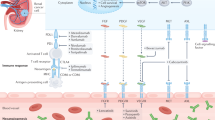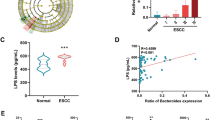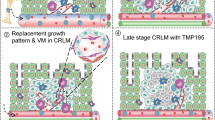Summary
Surgical removal of a primary tumour is often followed by rapid growth of previously dormant metastases. Endotoxin or lipopolysaccharide, a cell wall constituent of Gram-negative bacteria, is ubiquitously present in air and may be introduced during surgery. BALB/c mice received a tail vein injection of 105 4T1 mouse mammary carcinoma cells. Two weeks later, animals were subjected to surgical trauma or an intraperitoneal injection of endotoxin (10 μg per animal). Five days later, animals which underwent open surgery, laparoscopy with air sufflation or received an endotoxin injection displayed increased lung metastasis compared to anaesthetic controls. These increases in metastatic tumour growth were reflected in increased tumour cell proliferation and decreased apoptosis within lung metastases. Circulating levels of the angiogenic cytokine, vascular endothelial growth factor (VEGF), were also elevated in these groups and correlated with increased plasma levels of endotoxin. Endotoxin treatment for 18 h (>10 ng ml–1) directly up-regulated VEGF production by the 4T1 tumour cells in vitro. Metastatic tumour growth in mice undergoing carbon dioxide laparoscopy, where air is excluded, was similar to anaesthetic controls. These data indicate that endotoxin introduced during surgery is associated with the enhanced growth of metastases following surgical trauma, by altering the critical balances governing cellular growth and angiogenesis.
Similar content being viewed by others
Article PDF
Change history
16 November 2011
This paper was modified 12 months after initial publication to switch to Creative Commons licence terms, as noted at publication
References
Anan, K, Morisaki, T, Katano, M, Ikubo, A, Kitsuki, H, Uchiyama, A, Kuroki, S, Tanaka, M & Torisu, M (1996). Vascular endothelial growth factor and platelet-derived growth factor are potential angiogenic and metastatic factors in human breast cancer. Surgery 119: 333–339.
Arai, MD, Asakura, T & Nemir, P (1992). Effect of local tumour removal and retained oncolysate on lung metastasis. Ann Surg Res 53: 30–38.
Clauss, M, Gerlach, M, Gerlach, H, Brett, J, Wang, F, Familletti, PC, Pan, Y-CE, Olander, JV, Connolly, DT & Stern, D (1990). Vascular Permeability Factor: a tumour-derived polypeptide that induces endothelial cell and monocyte procoagulant activity, and promotes monocyte migration. J Exp Med 172: 1535–1545.
Crissman, JD, Hatfield, J, Menter, D, Sloane, B & Honn, K (1988). Morphological study of the interaction of intravascular tumour cells with endothelial cells and subendothelial matrix. Cancer Res 48: 4065–4072.
Da Costa, ML, Redmond, HP & Bouchier-Hayes, D (1998). The effect of laparotomy and laparoscopy on the establishment of spontaneous tumor metastases. Surgery 124: 516–525.
Fidler, IJ & Ellis, LM (1994). The implications of angiogenesis for the biology and therapy of cancer metastases. Cell 79: 185–188.
Folkman, J (1990). What is the evidence that tumours are angiogenesis dependent. J Natl Cancer Inst 82: 4–6.
Freeman, MR, Schneck, FX, Gagnon, ML, Corless, C, Soker, S, Niknejad, K, Peoples, GE & Klagsbrun, M (1995). Peripheral blood T lymphocytes and lymphocytes infiltrating human cancers express vascular endothelial growth factor: a potential role for T cells in angiogenesis. Cancer Res 55: 4140–4145.
Hansen, E, Norbert, W, Knuechel, R & Ruschoff, J (1995). Tumour cells in blood shed from the surgical field. Arch Surg 130: 387–393.
Harmey, JH, Dimitriadis, E, Kay, E, Redmond, HP & Bouchier-Hayes, DJ (1998). Regulation of macrophage production of vascular endothelial growth factor (VEGF) by hypoxia and transforming growth factor β-1. Ann Surg Oncol 5: 271–278.
Holmgren, L, O'Reilly, MS & Folkman, J (1995). Dormancy of micrometastases: balanced proliferation and apoptosis in the presence of angiogenesis suppression. Nat Med 1: 149–153.
Jiang, WG, Puntis, MCA & Hallett, MB (1994). Molecular and cellular basis of cancer invasion and metastasis: implications for treatment. Br J Surg 81: 1576–1590.
Kenyon, BM, Voest, EE, Chen, CC, Flynn, E, Folkman, J & D’Amato, RJ (1996). A model of angiogenesis in the mouse cornea. Invest Ophth Vis Sci 37: 1625–1632.
Kodama, M, Kodama, T, Nishi, Y & Totani, R (1992). Does surgical stress cause tumour metastasis?. Anticancer Res 12: 1603–1616.
Li, WW, Grayson, G, Folkman, J & D’Amore, PA (1991). Sustained-release endotoxin. A model for inducing corneal neovascularisation. Invest Ophth Vis Sci 32: 2906–2911.
Marmé, D (1996). Tumour angiogenesis: the pivotal role of vascular endothelial growth factor. World J Urol 14: 166–174.
Mattsby-Baltzer, I, Jakobsson, A, Sörbo, J & Norrby, K (1994). Endotoxin is angiogenic. Int J Exp Pathol 75: 191–196.
Nakamura, T, Ebihara, I, Fukai, M, Tomino, Y & Koide, H (1996). Modulation of endothelin family gene expression in renal hypertrophy. Nephron 73: 228–234.
Naylor, MS & Balkwill, FR (1995). The role of cytokines in tumour progression. In:Cell Proliferation and Cancer, Regulatory Mechanisms of Neoplastic Cell Growth, Pusztai L Lewis CE Yap EOxford University Press: New York 105–130.
O'Reilly, MS, Holmgren, L, Shing, Y, Chen, C, Rosenthal, RA, Moses, M, Lane, WS, Cao, Y, Sage, EH & Folkman, J (1994). Angiostatin: a novel angiogenesis inhibitor that mediates the suppression of metastases by a Lewis lung carcinoma. Cell 79: 315–328.
O'Reilly, MS, Boehm, T, Shing, Y, Fukai, N, Vasios, G, Lane, WS, Flynn, E, Birkhead, JR, Olsen, BR & Folkman, J (1997). Endostatin: An endogenous inhibitor of angiogenesis and tumour growth. Cell 88: 277–285.
Peters, KG, DeVries, C & Williams, LT (1993). Vascular endothelial growth factor expression during embryogenesis and tissue repair suggests a role in endothelial differentiation and blood vessel growth. Proc Natl Acad Sci (USA) 90: 8915–8919.
Rylander, R, Bake, B, Fischer, J & Helander, I (1989). Pulmonary function and symptoms after inhalation of endotoxin. Am Rev Respir Dis 140: 981–986.
Shapira, L, Takashiba, S, Champagne, C, Amar, S & VanDyke, T (1994). Involvement of protein kinase C and protein tyrosine kinase in lipopolysaccharide-induced TNF-α and IL-1β production by human monocytes. J Immunol 153: 1818–1824.
Skipper, D, Jeffrey, MJ, Cooper, AJ, Alexander, P & Taylor, I (1989). Enhanced growth of tumour cells in healing colonic anastomoses and laparotomy wounds. Int J Colorect Dis 4: 172–177.
Sunderkotter, C, Steinbrink, K, Goebeler, M, Bhardwaj, R & Sorg, C (1994). Macrophages and angiogenesis. J Leukoc Biol 55: 410–422.
Watson, RWG, Redmond, HP, McCarthy, J, Burke, PE & Bouchier-Hayes, D (1995). Exposure of the peritoneal cavity to air regulates early inflammatory responses to surgery in a murine model. Br J Surg 82: 1060–1065.
Weidner, MD, Semple, JP, Welch, WR & Folkman, J (1991). Tumour angiogenesis and metastasis – correlation in invasive breast carcinoma. N Engl J Med 324: 1–8.
Weinstein, SL, Sanghera, J, Lemke, K, Defranco, A & Pelech, S (1992). Bacterial lipopolysaccharide induces tyrosine phosphorylation and activation of mitogen-activated protein kinases in macrophages. J Biol Chem 267: 14955–14962.
Author information
Authors and Affiliations
Rights and permissions
From twelve months after its original publication, this work is licensed under the Creative Commons Attribution-NonCommercial-Share Alike 3.0 Unported License. To view a copy of this license, visit http://creativecommons.org/licenses/by-nc-sa/3.0/
About this article
Cite this article
Pidgeon, G., Harmey, J., Kay, E. et al. The role of endotoxin/lipopolysaccharide in surgically induced tumour growth in a murine model of metastatic disease. Br J Cancer 81, 1311–1317 (1999). https://doi.org/10.1038/sj.bjc.6694369
Received:
Revised:
Accepted:
Published:
Issue date:
DOI: https://doi.org/10.1038/sj.bjc.6694369
Keywords
This article is cited by
-
Hepatocellular carcinoma-derived high mobility group box 1 triggers M2 macrophage polarization via a TLR2/NOX2/autophagy axis
Scientific Reports (2020)
-
A history of exploring cancer in context
Nature Reviews Cancer (2018)
-
SOCS1 and pattern recognition receptors: TLR9 and RIG-I; novel haplotype associations in Egyptian fibrotic/cirrhotic patients with HCV genotype 4
Archives of Virology (2017)
-
Prolonged and repetitive exposure to Porphyromonas gingivalis increases aggressiveness of oral cancer cells by promoting acquisition of cancer stem cell properties
Tumor Biology (2015)
-
The same and not the same: heterogeneous functional activation of prostate tumor cells by TLR ligation
Cancer Cell International (2014)



